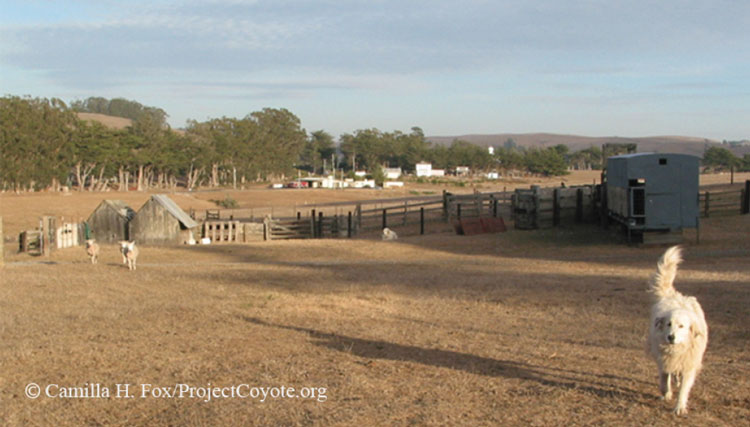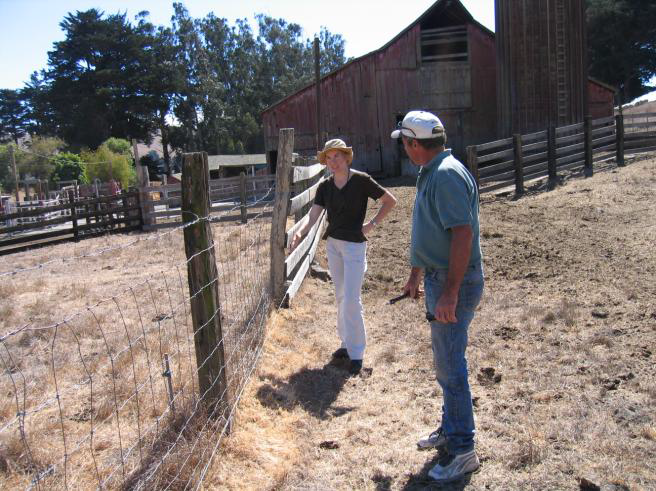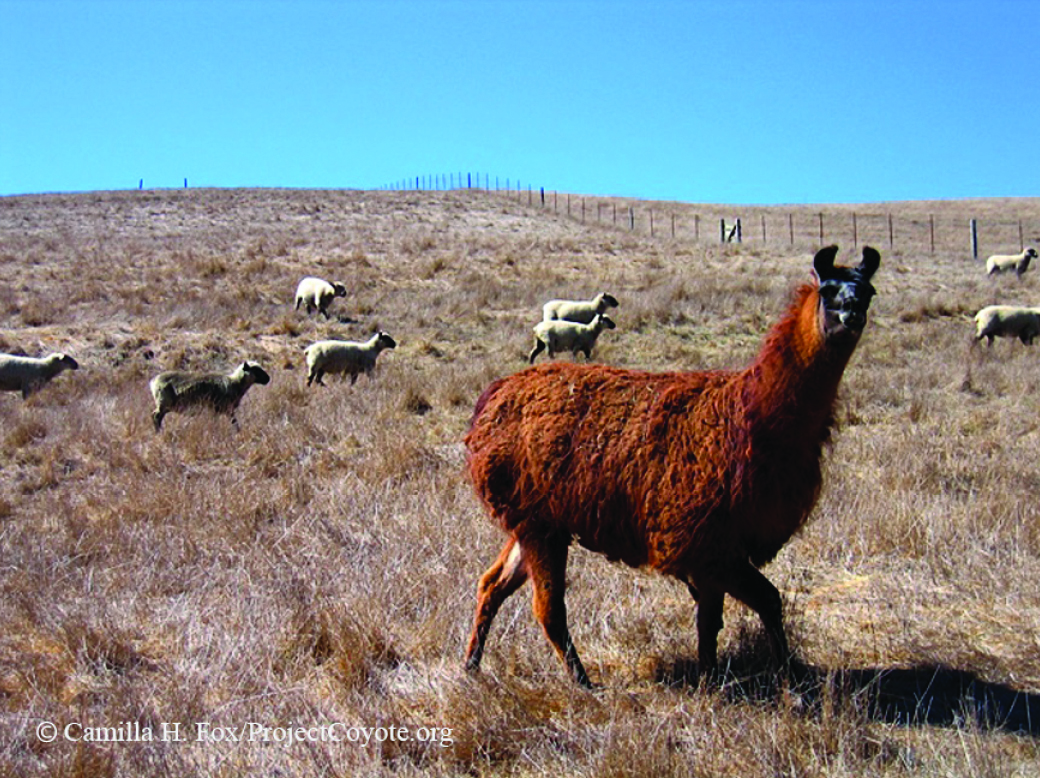A Non-Lethal Model for Coexistence
Photo: Camilla Fox, Executive Director of Project Coyote, and Bill Jensen of the Jensen Sheep Ranch in Marin County, California discuss fencing options under the Marin County Livestock & Wildlife Protection Program.
In the picturesque community of Marin County California just North of San Francisco – public controversy over the use of poisons, snares, “denning” (the killing of coyote and fox pups in their dens), and other lethal methods led to a majority decision by the Marin County Board of Supervisors to stop contracting with the U.S. Department of Agriculture’s Wildlife Services predator control program in 2000. Instead, the Board approved an alternative non-lethal community-based program to assist ranchers with livestock-predator conflicts known as the Marin County Livestock and Wildlife Protection Program (hereafter MCLWPP), a collaborative effort involving multiple stakeholders from local wildlife protection organizations to ranchers, scientists, and county government officials (Fox 2008).
The MCLWPP initiated cost-sharing to help ranchers install or upgrade fencing and other livestock-protection infrastructure, install predator-deterrents and detectors, and purchase and sustain guard dogs and llamas, coupled with indemnification for any ensuing verified livestock losses to predators. Improved animal husbandry practices combined with these economic and technological incentives led to its early success (Agocs 2007, Fox 2008).
Participants do not give up their rights to kill predators consistent with state and federal laws. Rather than contract with the USDA Wildlife Services (WS) to kill coyotes and other wildlife, the county assigns personnel and allocates money to help ranchers prevent depredations solely through non-lethal means. To qualify for the MCLWPP, ranchers must have 25 or more head of livestock and must utilize at least two non-lethal predation deterrent methods verified through inspection by the office of the Marin County Agricultural Commissioner, thereby becoming eligible for cost-share indemnification for any ensuing losses to predation.
Five years after implementation of the MCLWPP, a research assessment was conducted (Fox 2008) that compared the former Wildlife Services program to the MCLWPP, with regard to rancher satisfaction and preferences, lethality to predators, livestock losses, use of non-lethal predator deterrent techniques, and costs.
The study, conducted through a variety of quantitative and qualitative methods, including a comprehensive survey of ranchers who participated in the MCLWPP, documented the non-lethal cost-share program (1) had support from a majority of participating ranchers, (2) was preferred over the USDA Wildlife Service’s traditional predator management program by a majority of participating ranchers, (3) helped to reduce livestock losses, (4) resulted in an increase in the use of non-lethal predation deterrent methods by a majority of participating ranchers, (5) likely reduced the total number of predators killed to protect livestock, (6) reduced the spectrum of species of predators killed to protect livestock, and (7) fewer species of predator were killed.
In 2012, the San Francisco Chronicle (Fimrite 2012) reported that 26 Marin County ranchers participated in the County program employs 37 guard dogs, 31 llamas and over 30 miles of fencing, to protect 7,630 sheep that were pastured on 14,176 acres. Coyote depredation on sheep in the county, though it fluctuated, declined steadily from 236 in fiscal year 2002-03 to 90 in fiscal year 2010-11-a 62% reduction – with fourteen ranchers recording no predation losses and only three ranchers losing over ten sheep during the following year.
According to Marin Agricultural Commissioner, Stacy Carlsen, who oversees implementation of the non-lethal cost-share program, “losses fell from 5.0 to 2.2 percent while program costs fell by over $50,000. For the first couple of years we couldn’t tell if the loss reductions were a trend or a blip. Now, we can say there’s a definite pattern and livestock losses have decreased significantly.” Carlsen also noted
“This innovative model sets a precedent for meeting a wider compass of community needs and values where both agriculture and protection of wildlife are deemed important by the community. The success of our county model has set the trend for the rest of the nation.”
Moreover, on a holistic landscape level, the MCLWPP approach provides direct and immediate solutions to connect critical habitats for sustained carnivore populations.

A Great Pyrenees, one of the most dedicated livestock guard dogs in the world, protects sheep on a Marin County ranch. Ranchers also use Akbash, Maremma, Anatolian Shepherds and Komondors, all large breeds that instinctively bond with and protect sheep.
The heart of Marin County’s results-driven program lies in its eschewing of a governmental role in assisting in the destruction of wildlife, which makes the assistance in preventing depredations all the more attractive and ultimately successful. The Marin County Livestock and Wildlife Protection Program provides a cost-effective and ecologically beneficial model to address carnivore-livestock conflicts by integrating modern science, ethics, and economics. Such innovative prototyping that incorporates adaptive management strategies provides a template to guide the development of other non-lethal programs across differing landscapes to address the age-old predicament of raising livestock in an environment that includes predators (Fox 2008).


